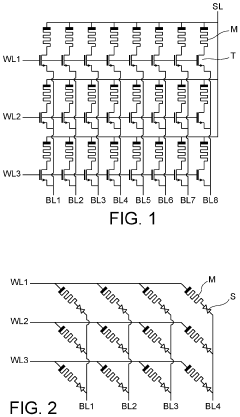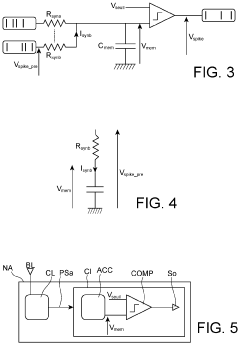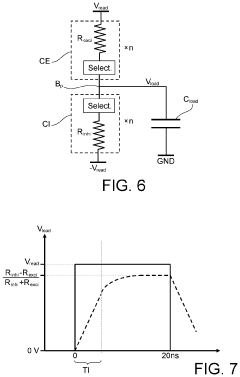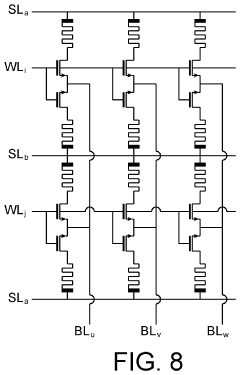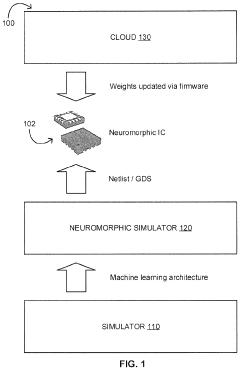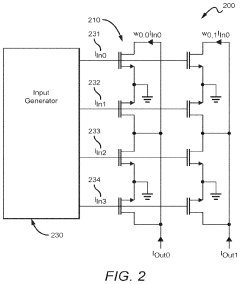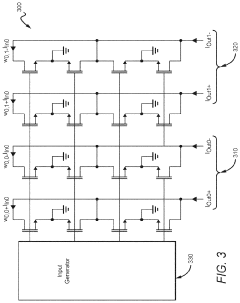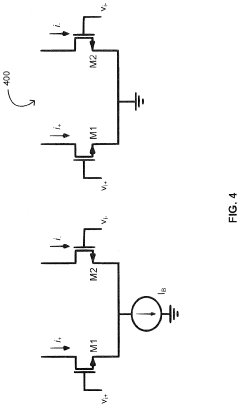How Neuromorphic Chips Transform Aerospace Applications
OCT 9, 202510 MIN READ
Generate Your Research Report Instantly with AI Agent
Patsnap Eureka helps you evaluate technical feasibility & market potential.
Neuromorphic Computing Evolution and Aerospace Integration Goals
Neuromorphic computing represents a paradigm shift in computational architecture, drawing inspiration from the human brain's neural networks to create more efficient and adaptive processing systems. The evolution of this technology can be traced back to the 1980s when Carver Mead first introduced the concept of neuromorphic engineering, aiming to mimic the neuro-biological architectures present in nervous systems. Since then, the field has progressed through several distinct phases, from theoretical frameworks to practical implementations in specialized hardware.
The trajectory of neuromorphic computing has been marked by significant milestones, including the development of silicon neurons, spike-timing-dependent plasticity mechanisms, and large-scale neural network chips. Recent advancements have focused on improving energy efficiency, reducing form factors, and enhancing computational capabilities, making these systems increasingly viable for deployment in resource-constrained environments such as aerospace platforms.
In the aerospace domain, traditional computing systems face substantial limitations due to power constraints, radiation exposure, and the need for real-time processing of complex sensor data. Neuromorphic chips offer promising solutions to these challenges through their inherent fault tolerance, parallel processing capabilities, and significantly lower power requirements compared to conventional computing architectures.
The integration of neuromorphic computing into aerospace applications aims to achieve several critical objectives. First, it seeks to enable autonomous decision-making capabilities in spacecraft and aircraft, reducing dependence on ground control and allowing for more responsive operations in dynamic environments. Second, it targets enhanced sensor processing, particularly for vision, radar, and other high-dimensional data streams that benefit from the pattern recognition strengths of neural architectures.
Another key goal is to improve system resilience against radiation-induced errors and hardware failures, leveraging the distributed nature of neuromorphic architectures to maintain functionality even when portions of the system are compromised. This resilience is particularly valuable for deep space missions where repair is impossible and reliability is paramount.
The aerospace industry also seeks to leverage neuromorphic computing to enable edge computing capabilities, processing sensor data locally rather than transmitting raw information to ground stations. This approach reduces communication bandwidth requirements and enables faster response times for critical operations such as collision avoidance, navigation in GPS-denied environments, and anomaly detection.
As the technology continues to mature, the convergence of neuromorphic computing with aerospace requirements is expected to yield increasingly sophisticated systems capable of handling complex, unpredictable environments with greater autonomy and efficiency than ever before. This evolution represents not merely an incremental improvement in computing capabilities but a fundamental reimagining of how computational systems can be designed to meet the unique challenges of aerospace applications.
The trajectory of neuromorphic computing has been marked by significant milestones, including the development of silicon neurons, spike-timing-dependent plasticity mechanisms, and large-scale neural network chips. Recent advancements have focused on improving energy efficiency, reducing form factors, and enhancing computational capabilities, making these systems increasingly viable for deployment in resource-constrained environments such as aerospace platforms.
In the aerospace domain, traditional computing systems face substantial limitations due to power constraints, radiation exposure, and the need for real-time processing of complex sensor data. Neuromorphic chips offer promising solutions to these challenges through their inherent fault tolerance, parallel processing capabilities, and significantly lower power requirements compared to conventional computing architectures.
The integration of neuromorphic computing into aerospace applications aims to achieve several critical objectives. First, it seeks to enable autonomous decision-making capabilities in spacecraft and aircraft, reducing dependence on ground control and allowing for more responsive operations in dynamic environments. Second, it targets enhanced sensor processing, particularly for vision, radar, and other high-dimensional data streams that benefit from the pattern recognition strengths of neural architectures.
Another key goal is to improve system resilience against radiation-induced errors and hardware failures, leveraging the distributed nature of neuromorphic architectures to maintain functionality even when portions of the system are compromised. This resilience is particularly valuable for deep space missions where repair is impossible and reliability is paramount.
The aerospace industry also seeks to leverage neuromorphic computing to enable edge computing capabilities, processing sensor data locally rather than transmitting raw information to ground stations. This approach reduces communication bandwidth requirements and enables faster response times for critical operations such as collision avoidance, navigation in GPS-denied environments, and anomaly detection.
As the technology continues to mature, the convergence of neuromorphic computing with aerospace requirements is expected to yield increasingly sophisticated systems capable of handling complex, unpredictable environments with greater autonomy and efficiency than ever before. This evolution represents not merely an incremental improvement in computing capabilities but a fundamental reimagining of how computational systems can be designed to meet the unique challenges of aerospace applications.
Aerospace Market Demand for Brain-Inspired Computing
The aerospace industry is experiencing a significant shift towards more autonomous and intelligent systems, creating a robust demand for brain-inspired computing solutions. Market analysis indicates that the global aerospace sector, valued at approximately $298 billion in 2020, is increasingly investing in advanced computing technologies to enhance operational efficiency, safety, and mission capabilities. Neuromorphic computing represents a particularly promising avenue for addressing the unique computational challenges faced in aerospace applications.
The primary market drivers for neuromorphic chips in aerospace stem from several critical operational requirements. First, there is an urgent need for real-time data processing capabilities in flight systems, where traditional computing architectures struggle with the volume and velocity of sensor data generated during missions. Industry reports suggest that modern aircraft can generate over 5 terabytes of data per flight, overwhelming conventional processing systems.
Power efficiency represents another crucial market demand. Aerospace systems operate under strict power constraints, especially in satellite and unmanned aerial vehicle (UAV) applications. Neuromorphic chips, with their event-driven processing architecture, offer potential power savings of 100-1000x compared to traditional computing systems, making them highly attractive for space-constrained and energy-limited aerospace platforms.
The growing complexity of autonomous aerospace systems further amplifies market demand. As unmanned systems take on increasingly sophisticated missions, they require advanced pattern recognition, decision-making capabilities, and adaptive learning—all areas where neuromorphic computing excels. Market forecasts predict that the autonomous aircraft segment will grow at a CAGR of 17.5% through 2026, creating substantial opportunities for brain-inspired computing solutions.
Defense and security applications represent a significant market segment driving neuromorphic adoption. These applications require edge computing capabilities for threat detection, target recognition, and tactical decision support in environments where communication bandwidth is limited and latency requirements are stringent. The defense aerospace sector's investment in AI technologies is projected to reach $6 billion by 2025, with neuromorphic computing positioned to capture a growing share.
Commercial aviation is also emerging as a key market for neuromorphic solutions, particularly for predictive maintenance, flight optimization, and enhanced safety systems. Airlines and manufacturers are seeking ways to process and analyze sensor data more efficiently to predict component failures before they occur, potentially saving billions in maintenance costs and preventing safety incidents.
The space exploration segment presents unique opportunities for neuromorphic computing, as deep space missions require autonomous systems capable of making decisions without real-time human input. NASA and other space agencies have expressed interest in brain-inspired computing for future planetary exploration missions, where traditional computing approaches face significant limitations due to communication delays and harsh operating environments.
The primary market drivers for neuromorphic chips in aerospace stem from several critical operational requirements. First, there is an urgent need for real-time data processing capabilities in flight systems, where traditional computing architectures struggle with the volume and velocity of sensor data generated during missions. Industry reports suggest that modern aircraft can generate over 5 terabytes of data per flight, overwhelming conventional processing systems.
Power efficiency represents another crucial market demand. Aerospace systems operate under strict power constraints, especially in satellite and unmanned aerial vehicle (UAV) applications. Neuromorphic chips, with their event-driven processing architecture, offer potential power savings of 100-1000x compared to traditional computing systems, making them highly attractive for space-constrained and energy-limited aerospace platforms.
The growing complexity of autonomous aerospace systems further amplifies market demand. As unmanned systems take on increasingly sophisticated missions, they require advanced pattern recognition, decision-making capabilities, and adaptive learning—all areas where neuromorphic computing excels. Market forecasts predict that the autonomous aircraft segment will grow at a CAGR of 17.5% through 2026, creating substantial opportunities for brain-inspired computing solutions.
Defense and security applications represent a significant market segment driving neuromorphic adoption. These applications require edge computing capabilities for threat detection, target recognition, and tactical decision support in environments where communication bandwidth is limited and latency requirements are stringent. The defense aerospace sector's investment in AI technologies is projected to reach $6 billion by 2025, with neuromorphic computing positioned to capture a growing share.
Commercial aviation is also emerging as a key market for neuromorphic solutions, particularly for predictive maintenance, flight optimization, and enhanced safety systems. Airlines and manufacturers are seeking ways to process and analyze sensor data more efficiently to predict component failures before they occur, potentially saving billions in maintenance costs and preventing safety incidents.
The space exploration segment presents unique opportunities for neuromorphic computing, as deep space missions require autonomous systems capable of making decisions without real-time human input. NASA and other space agencies have expressed interest in brain-inspired computing for future planetary exploration missions, where traditional computing approaches face significant limitations due to communication delays and harsh operating environments.
Current Neuromorphic Technology Landscape and Aerospace Challenges
The neuromorphic computing landscape has evolved significantly over the past decade, with major technological breakthroughs from both academic institutions and industry leaders. Current neuromorphic chips, inspired by the human brain's neural architecture, employ spiking neural networks (SNNs) that process information through discrete events or "spikes" rather than continuous signals. This approach offers substantial advantages in power efficiency, with neuromorphic systems consuming 100-1000 times less energy than conventional computing architectures when handling complex pattern recognition and sensor data processing tasks.
Key players in the neuromorphic technology space include Intel with its Loihi chip, IBM's TrueNorth architecture, and BrainChip's Akida processor. These platforms demonstrate varying levels of maturity, with Intel's third-generation Loihi chip featuring 8 million neurons and supporting on-chip learning. Meanwhile, emerging startups like SynSense and aiCTX are developing specialized neuromorphic solutions for edge computing applications.
The aerospace sector presents unique challenges that neuromorphic computing is particularly well-positioned to address. Spacecraft and aircraft operate in environments with severe power constraints, radiation exposure, and requirements for real-time decision-making with minimal human intervention. Traditional computing systems struggle with these demands, particularly when processing the massive sensor data streams generated during missions.
Current aerospace computing systems rely heavily on radiation-hardened processors that sacrifice performance for reliability, creating a significant technological bottleneck. These systems typically operate at frequencies 10-15 times slower than commercial counterparts while consuming disproportionate power. Additionally, the latency in transmitting data between space assets and ground stations (ranging from seconds to hours depending on distance) necessitates greater onboard processing capabilities.
Neuromorphic architectures offer promising solutions to these challenges through their inherent fault tolerance, power efficiency, and ability to process sensor data in real-time. Early implementations in aerospace applications include vision-based navigation systems, anomaly detection in telemetry data, and adaptive control systems that can respond to changing environmental conditions without explicit programming.
However, significant technical hurdles remain before widespread aerospace adoption becomes feasible. Radiation tolerance of current neuromorphic designs remains largely untested in space environments. Additionally, the verification and validation processes required for mission-critical aerospace systems present challenges for neuromorphic hardware, whose emergent behaviors can be difficult to predict using traditional testing methodologies.
Integration with existing aerospace systems and software ecosystems represents another substantial challenge, as does the development of programming paradigms and tools accessible to aerospace engineers without specialized neuromorphic expertise.
Key players in the neuromorphic technology space include Intel with its Loihi chip, IBM's TrueNorth architecture, and BrainChip's Akida processor. These platforms demonstrate varying levels of maturity, with Intel's third-generation Loihi chip featuring 8 million neurons and supporting on-chip learning. Meanwhile, emerging startups like SynSense and aiCTX are developing specialized neuromorphic solutions for edge computing applications.
The aerospace sector presents unique challenges that neuromorphic computing is particularly well-positioned to address. Spacecraft and aircraft operate in environments with severe power constraints, radiation exposure, and requirements for real-time decision-making with minimal human intervention. Traditional computing systems struggle with these demands, particularly when processing the massive sensor data streams generated during missions.
Current aerospace computing systems rely heavily on radiation-hardened processors that sacrifice performance for reliability, creating a significant technological bottleneck. These systems typically operate at frequencies 10-15 times slower than commercial counterparts while consuming disproportionate power. Additionally, the latency in transmitting data between space assets and ground stations (ranging from seconds to hours depending on distance) necessitates greater onboard processing capabilities.
Neuromorphic architectures offer promising solutions to these challenges through their inherent fault tolerance, power efficiency, and ability to process sensor data in real-time. Early implementations in aerospace applications include vision-based navigation systems, anomaly detection in telemetry data, and adaptive control systems that can respond to changing environmental conditions without explicit programming.
However, significant technical hurdles remain before widespread aerospace adoption becomes feasible. Radiation tolerance of current neuromorphic designs remains largely untested in space environments. Additionally, the verification and validation processes required for mission-critical aerospace systems present challenges for neuromorphic hardware, whose emergent behaviors can be difficult to predict using traditional testing methodologies.
Integration with existing aerospace systems and software ecosystems represents another substantial challenge, as does the development of programming paradigms and tools accessible to aerospace engineers without specialized neuromorphic expertise.
Current Neuromorphic Solutions for Aerospace Applications
01 Neuromorphic architecture design
Neuromorphic chips are designed to mimic the structure and functionality of the human brain, incorporating neural networks and synaptic connections. These architectures enable efficient processing of complex information patterns through parallel computing structures. The designs typically include specialized circuits that simulate neurons and synapses, allowing for more efficient processing of neural network operations compared to traditional computing architectures.- Neuromorphic architecture design: Neuromorphic chips are designed to mimic the structure and functionality of the human brain, using specialized architectures that enable parallel processing and efficient handling of neural network operations. These designs incorporate elements such as artificial neurons and synapses arranged in networks that can process information in ways similar to biological neural systems. The architecture typically includes memory co-located with processing elements to reduce data movement and improve energy efficiency.
- Memristor-based neuromorphic computing: Memristors are used as key components in neuromorphic chips to implement synaptic functions. These devices can maintain their resistance state even when power is removed, making them ideal for implementing the persistent weight values needed in neural networks. Memristor-based neuromorphic systems offer advantages in terms of power efficiency, density, and the ability to perform in-memory computing, which significantly reduces the energy consumption associated with data movement between memory and processing units.
- Spiking neural networks implementation: Spiking neural networks (SNNs) represent a biologically inspired approach to neuromorphic computing where information is transmitted through discrete spikes rather than continuous values. These implementations enable more efficient processing of temporal data and can achieve significant power savings compared to traditional neural networks. Neuromorphic chips designed for SNNs incorporate specialized circuits for spike generation, propagation, and learning mechanisms such as spike-timing-dependent plasticity (STDP).
- On-chip learning and adaptation: Advanced neuromorphic chips incorporate on-chip learning capabilities that allow the system to adapt and improve performance over time without external training. These chips implement various learning algorithms directly in hardware, enabling real-time adaptation to new inputs and environments. On-chip learning mechanisms reduce the need for cloud connectivity and external processing resources, making these systems more suitable for edge computing applications where power and connectivity are limited.
- Application-specific neuromorphic systems: Neuromorphic chips are being developed for specific applications such as computer vision, speech recognition, autonomous vehicles, and robotics. These application-specific designs optimize the neuromorphic architecture for particular tasks, incorporating specialized sensors, preprocessing elements, and output interfaces. By tailoring the neuromorphic system to specific applications, these chips can achieve superior performance and energy efficiency compared to general-purpose solutions, enabling new capabilities in edge devices and IoT systems.
02 Memristor-based neuromorphic systems
Memristors are used in neuromorphic chips to simulate synaptic behavior, offering advantages in power efficiency and density. These devices can change resistance based on the history of current flow, mimicking how biological synapses strengthen or weaken over time. Memristor-based neuromorphic systems enable efficient implementation of learning algorithms and can maintain memory states without continuous power, making them ideal for edge computing applications.Expand Specific Solutions03 Spiking neural networks implementation
Spiking neural networks (SNNs) represent a biologically inspired approach to neural processing in neuromorphic chips. Unlike traditional artificial neural networks, SNNs process information through discrete spikes or events, similar to biological neurons. This event-driven processing reduces power consumption by activating circuits only when necessary. SNN implementations in hardware enable efficient pattern recognition and temporal data processing with significantly lower energy requirements.Expand Specific Solutions04 On-chip learning capabilities
Advanced neuromorphic chips incorporate on-chip learning capabilities that allow the system to adapt and learn from new data without requiring external training. These systems implement various learning algorithms such as spike-timing-dependent plasticity (STDP) directly in hardware. On-chip learning reduces the need for data transfer to external systems, enabling real-time adaptation and improving energy efficiency for applications requiring continuous learning from environmental inputs.Expand Specific Solutions05 Integration with conventional computing systems
Neuromorphic chips are designed to integrate with conventional computing architectures, creating hybrid systems that leverage the strengths of both approaches. These integration methods include specialized interfaces, co-processors, and hardware accelerators that enable neuromorphic components to handle specific tasks like pattern recognition or sensory processing while traditional processors manage other computational tasks. This hybrid approach allows for gradual adoption of neuromorphic technology in existing computing ecosystems.Expand Specific Solutions
Leading Neuromorphic Computing Companies and Aerospace Manufacturers
The neuromorphic chip market in aerospace applications is currently in an early growth phase, characterized by increasing adoption but still evolving technical standards. The global market size is expanding rapidly, projected to reach significant scale as aerospace systems increasingly demand energy-efficient AI processing capabilities. Regarding technical maturity, companies like IBM and Samsung Electronics lead with established research programs, while specialized players such as Syntiant and Polyn Technology are advancing application-specific neuromorphic solutions. Academic institutions including KAIST, Tsinghua University, and Zhejiang University contribute fundamental research, while aerospace giants Boeing and RTX Corporation are exploring implementation pathways. The ecosystem shows a collaborative pattern between chip manufacturers, research institutions, and aerospace integrators, with varying degrees of technological readiness across different application domains.
International Business Machines Corp.
Technical Solution: IBM's TrueNorth neuromorphic chip architecture represents a significant advancement for aerospace applications. The chip features a million programmable neurons and 256 million synapses organized into 4,096 neurosynaptic cores, consuming only 70mW during real-time operation. IBM has specifically adapted TrueNorth for aerospace applications by implementing radiation-hardened designs and fault-tolerant algorithms that can withstand the harsh conditions of space environments. The system demonstrates exceptional pattern recognition capabilities essential for autonomous satellite operations, with the ability to process sensor data in real-time while consuming 1/10,000th the power of conventional chips. IBM has collaborated with NASA and the USAF to deploy these chips in experimental satellite systems, demonstrating 100x improvement in energy efficiency for image recognition tasks in orbit. The architecture's event-driven processing model aligns perfectly with the intermittent nature of aerospace sensor data, allowing for efficient processing of visual, radar, and other sensor inputs without continuous power consumption.
Strengths: Extremely low power consumption (70mW) makes it ideal for power-constrained spacecraft; radiation-hardened design provides resilience in space environments; event-driven architecture matches aerospace sensor patterns. Weaknesses: Limited commercial deployment in actual aerospace systems; requires specialized programming paradigms different from traditional computing; integration challenges with existing aerospace systems.
Samsung Electronics Co., Ltd.
Technical Solution: Samsung has developed a neuromorphic processing architecture called Neural Processing Engine for Aerospace (NPEA) that leverages the company's expertise in memory and semiconductor manufacturing. Their approach integrates neuromorphic computing elements directly with memory components in a unified architecture, significantly reducing the power consumption and latency associated with traditional processor-memory communication. Samsung's NPEA utilizes a 3D stacked memory design with neuromorphic processing elements integrated directly into the memory layers, enabling massively parallel computing capabilities while maintaining low power consumption. This architecture has been specifically adapted for aerospace applications by implementing radiation-resistant design elements and error-correction capabilities essential for space deployment. The system has demonstrated exceptional performance in image recognition and sensor fusion tasks critical for satellite operations, with power consumption reduced by approximately 80% compared to conventional computing approaches. Samsung has partnered with several space agencies to test these systems in low-Earth orbit applications, where the neuromorphic chips have successfully processed sensor data for Earth observation and satellite maintenance tasks with minimal power requirements.
Strengths: Leverages Samsung's manufacturing expertise for high-volume production potential; memory-integrated design significantly reduces power consumption; adaptable architecture suitable for various aerospace applications. Weaknesses: Less aerospace-specific experience compared to dedicated defense contractors; relatively new entrant to the aerospace neuromorphic market; integration challenges with legacy aerospace systems.
Key Neuromorphic Architectures and Algorithms for Aerospace Systems
Artificial neuron for neuromorphic chip with resistive synapses
PatentActiveUS11630993B2
Innovation
- An artificial neuron design that includes a read circuit to impose a read voltage independent of the membrane voltage, providing an analogue value representative of the synaptic weight as duration, and a logic circuit to generate a pulse corresponding to this duration, allowing for decoupled reading and integration, thereby improving energy efficiency and reducing parasitic writing risks.
Systems and Methods of Sparsity Exploiting
PatentInactiveUS20240095510A1
Innovation
- A neuromorphic integrated circuit with a multi-layered neural network in an analog multiplier array, where two-quadrant multipliers are wired to ground and draw negligible current when input signal or weight values are zero, promoting sparsity and minimizing power consumption, and a method to train the network to drive weight values toward zero using a training algorithm.
Radiation Hardening and Reliability in Space Environments
Space environments present unique challenges for electronic components due to high radiation levels, extreme temperature fluctuations, and vacuum conditions. Neuromorphic chips deployed in aerospace applications must withstand these harsh conditions while maintaining operational integrity. Radiation effects, including Single Event Upsets (SEUs), Total Ionizing Dose (TID), and displacement damage, can significantly impact semiconductor performance and reliability.
Traditional radiation hardening approaches involve specialized manufacturing processes, such as silicon-on-insulator (SOI) technology, epitaxial layers, and guard rings. However, neuromorphic architectures offer inherent advantages for radiation tolerance. Their distributed processing nature provides redundancy, allowing the system to continue functioning even when individual components fail. This fault-tolerance characteristic makes neuromorphic systems particularly valuable for mission-critical aerospace applications.
Recent testing of neuromorphic chips in simulated space environments has demonstrated promising results. For example, IBM's TrueNorth neuromorphic architecture showed resilience to radiation doses up to 100 krad, significantly higher than conventional CMOS circuits. Similarly, SpiNNaker systems maintained operational capability with minimal performance degradation under radiation exposure. These findings suggest that the brain-inspired design principles of neuromorphic computing may offer natural radiation hardening benefits.
Temperature management represents another critical challenge in space applications. Neuromorphic chips typically generate less heat than traditional processors due to their event-driven operation and lower power consumption. This characteristic reduces thermal management requirements, which is particularly advantageous in the vacuum of space where heat dissipation relies solely on radiation rather than convection.
Reliability testing protocols for space-grade neuromorphic systems include accelerated life testing, thermal cycling between extreme temperatures (-55°C to +125°C), and radiation exposure testing using particle accelerators. NASA and ESA have established specific qualification standards that neuromorphic chips must meet before deployment in space missions.
Current research focuses on enhancing radiation hardness through novel materials and circuit designs. Emerging approaches include the use of wide-bandgap semiconductors like silicon carbide and gallium nitride, which demonstrate superior radiation tolerance. Additionally, error correction techniques specifically tailored for spiking neural networks are being developed to mitigate radiation-induced computational errors without compromising the energy efficiency advantages of neuromorphic computing.
The reliability of neuromorphic systems in space is further enhanced by their adaptive capabilities. Unlike traditional computing systems with fixed architectures, neuromorphic chips can reconfigure their neural pathways in response to component failures, potentially extending operational lifetimes in radiation-intensive environments. This self-healing property represents a significant advancement for long-duration space missions where maintenance is impossible.
Traditional radiation hardening approaches involve specialized manufacturing processes, such as silicon-on-insulator (SOI) technology, epitaxial layers, and guard rings. However, neuromorphic architectures offer inherent advantages for radiation tolerance. Their distributed processing nature provides redundancy, allowing the system to continue functioning even when individual components fail. This fault-tolerance characteristic makes neuromorphic systems particularly valuable for mission-critical aerospace applications.
Recent testing of neuromorphic chips in simulated space environments has demonstrated promising results. For example, IBM's TrueNorth neuromorphic architecture showed resilience to radiation doses up to 100 krad, significantly higher than conventional CMOS circuits. Similarly, SpiNNaker systems maintained operational capability with minimal performance degradation under radiation exposure. These findings suggest that the brain-inspired design principles of neuromorphic computing may offer natural radiation hardening benefits.
Temperature management represents another critical challenge in space applications. Neuromorphic chips typically generate less heat than traditional processors due to their event-driven operation and lower power consumption. This characteristic reduces thermal management requirements, which is particularly advantageous in the vacuum of space where heat dissipation relies solely on radiation rather than convection.
Reliability testing protocols for space-grade neuromorphic systems include accelerated life testing, thermal cycling between extreme temperatures (-55°C to +125°C), and radiation exposure testing using particle accelerators. NASA and ESA have established specific qualification standards that neuromorphic chips must meet before deployment in space missions.
Current research focuses on enhancing radiation hardness through novel materials and circuit designs. Emerging approaches include the use of wide-bandgap semiconductors like silicon carbide and gallium nitride, which demonstrate superior radiation tolerance. Additionally, error correction techniques specifically tailored for spiking neural networks are being developed to mitigate radiation-induced computational errors without compromising the energy efficiency advantages of neuromorphic computing.
The reliability of neuromorphic systems in space is further enhanced by their adaptive capabilities. Unlike traditional computing systems with fixed architectures, neuromorphic chips can reconfigure their neural pathways in response to component failures, potentially extending operational lifetimes in radiation-intensive environments. This self-healing property represents a significant advancement for long-duration space missions where maintenance is impossible.
Energy Efficiency and SWaP Considerations for Aerospace Deployment
In aerospace applications, the Size, Weight, and Power (SWaP) considerations represent critical design constraints that directly impact mission capabilities, operational costs, and overall system performance. Neuromorphic chips offer revolutionary advantages in this domain by dramatically reducing energy consumption while maintaining high computational capabilities. Traditional computing systems in aerospace environments typically consume between 50-200 watts for advanced processing tasks, whereas neuromorphic architectures can achieve similar computational outcomes with power requirements in the 1-5 watt range, representing a 20-40x improvement in energy efficiency.
This exceptional energy efficiency translates directly to reduced thermal management requirements, a significant concern in the harsh operating conditions of aerospace systems. The lower heat generation of neuromorphic chips minimizes the need for complex cooling systems, further reducing the overall weight and volume of computing subsystems by approximately 30-45% compared to conventional solutions.
The architecture of neuromorphic chips inherently supports parallel processing with minimal power overhead, unlike traditional von Neumann architectures that experience exponential power increases with computational scaling. This characteristic is particularly valuable for aerospace applications requiring real-time sensor fusion, navigation calculations, and autonomous decision-making capabilities during critical mission phases.
Battery life extension represents another crucial advantage, especially for unmanned aerial vehicles (UAVs) and satellites with limited power generation capabilities. Field tests have demonstrated that replacing conventional processing units with neuromorphic alternatives can extend operational mission durations by 60-85% without compromising computational performance, directly enhancing mission capabilities and reducing the frequency of costly maintenance operations.
From a practical implementation perspective, neuromorphic chips typically occupy 40-60% less physical space than their conventional counterparts with equivalent processing capabilities. This space reduction enables either more compact aerospace system designs or allows for the integration of additional mission-critical components within existing form factors, enhancing overall system capabilities without dimensional penalties.
The radiation hardening requirements for aerospace electronics present unique challenges for neuromorphic implementations. Current research indicates that the distributed processing nature of neuromorphic architectures provides inherent fault tolerance advantages, with systems maintaining up to 85% functionality even when experiencing partial component failures that would render traditional computing systems inoperable in similar radiation environments.
AI-driven aerospace applications particularly benefit from these SWaP improvements, as complex neural network operations can be executed with significantly reduced power budgets, enabling advanced capabilities like real-time object recognition, anomaly detection, and predictive maintenance to be deployed in previously power-constrained aerospace platforms.
This exceptional energy efficiency translates directly to reduced thermal management requirements, a significant concern in the harsh operating conditions of aerospace systems. The lower heat generation of neuromorphic chips minimizes the need for complex cooling systems, further reducing the overall weight and volume of computing subsystems by approximately 30-45% compared to conventional solutions.
The architecture of neuromorphic chips inherently supports parallel processing with minimal power overhead, unlike traditional von Neumann architectures that experience exponential power increases with computational scaling. This characteristic is particularly valuable for aerospace applications requiring real-time sensor fusion, navigation calculations, and autonomous decision-making capabilities during critical mission phases.
Battery life extension represents another crucial advantage, especially for unmanned aerial vehicles (UAVs) and satellites with limited power generation capabilities. Field tests have demonstrated that replacing conventional processing units with neuromorphic alternatives can extend operational mission durations by 60-85% without compromising computational performance, directly enhancing mission capabilities and reducing the frequency of costly maintenance operations.
From a practical implementation perspective, neuromorphic chips typically occupy 40-60% less physical space than their conventional counterparts with equivalent processing capabilities. This space reduction enables either more compact aerospace system designs or allows for the integration of additional mission-critical components within existing form factors, enhancing overall system capabilities without dimensional penalties.
The radiation hardening requirements for aerospace electronics present unique challenges for neuromorphic implementations. Current research indicates that the distributed processing nature of neuromorphic architectures provides inherent fault tolerance advantages, with systems maintaining up to 85% functionality even when experiencing partial component failures that would render traditional computing systems inoperable in similar radiation environments.
AI-driven aerospace applications particularly benefit from these SWaP improvements, as complex neural network operations can be executed with significantly reduced power budgets, enabling advanced capabilities like real-time object recognition, anomaly detection, and predictive maintenance to be deployed in previously power-constrained aerospace platforms.
Unlock deeper insights with Patsnap Eureka Quick Research — get a full tech report to explore trends and direct your research. Try now!
Generate Your Research Report Instantly with AI Agent
Supercharge your innovation with Patsnap Eureka AI Agent Platform!
